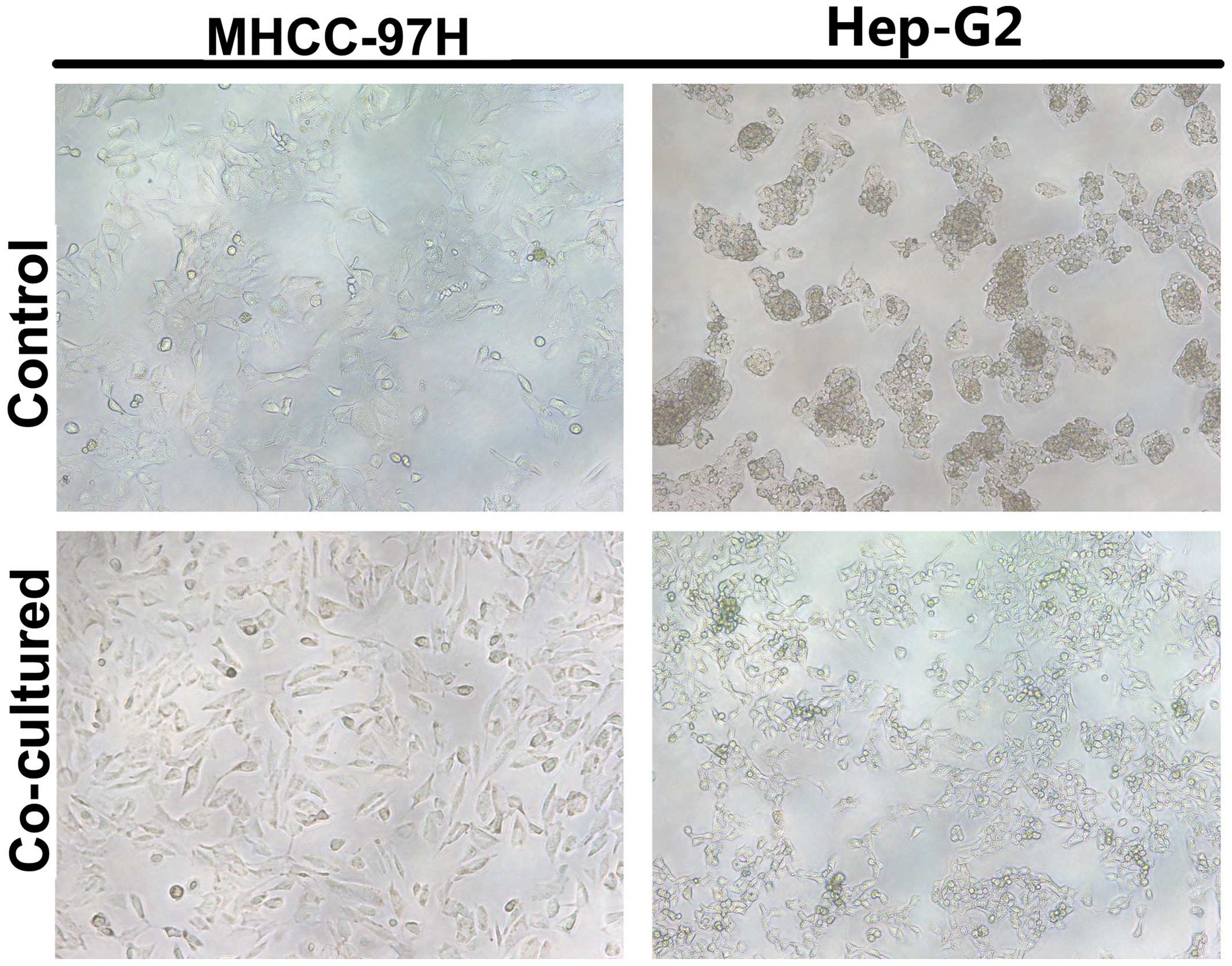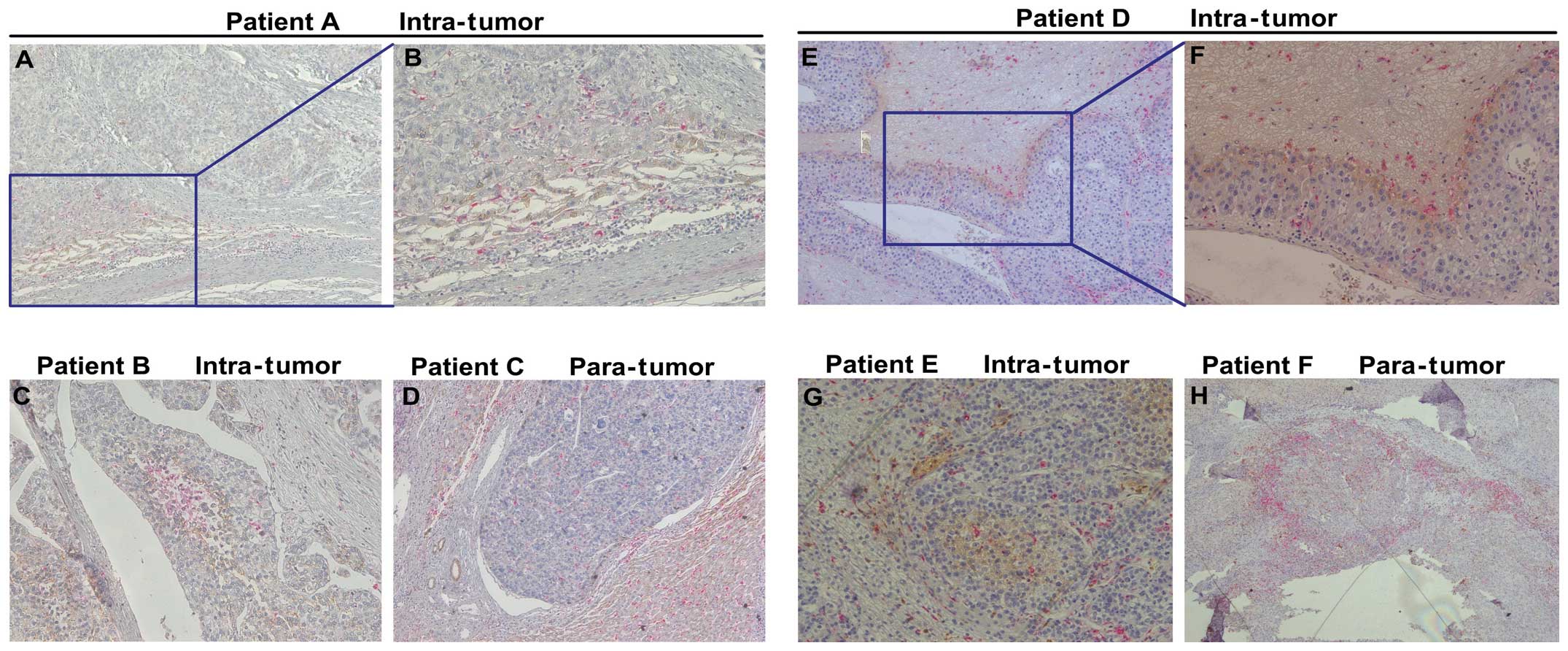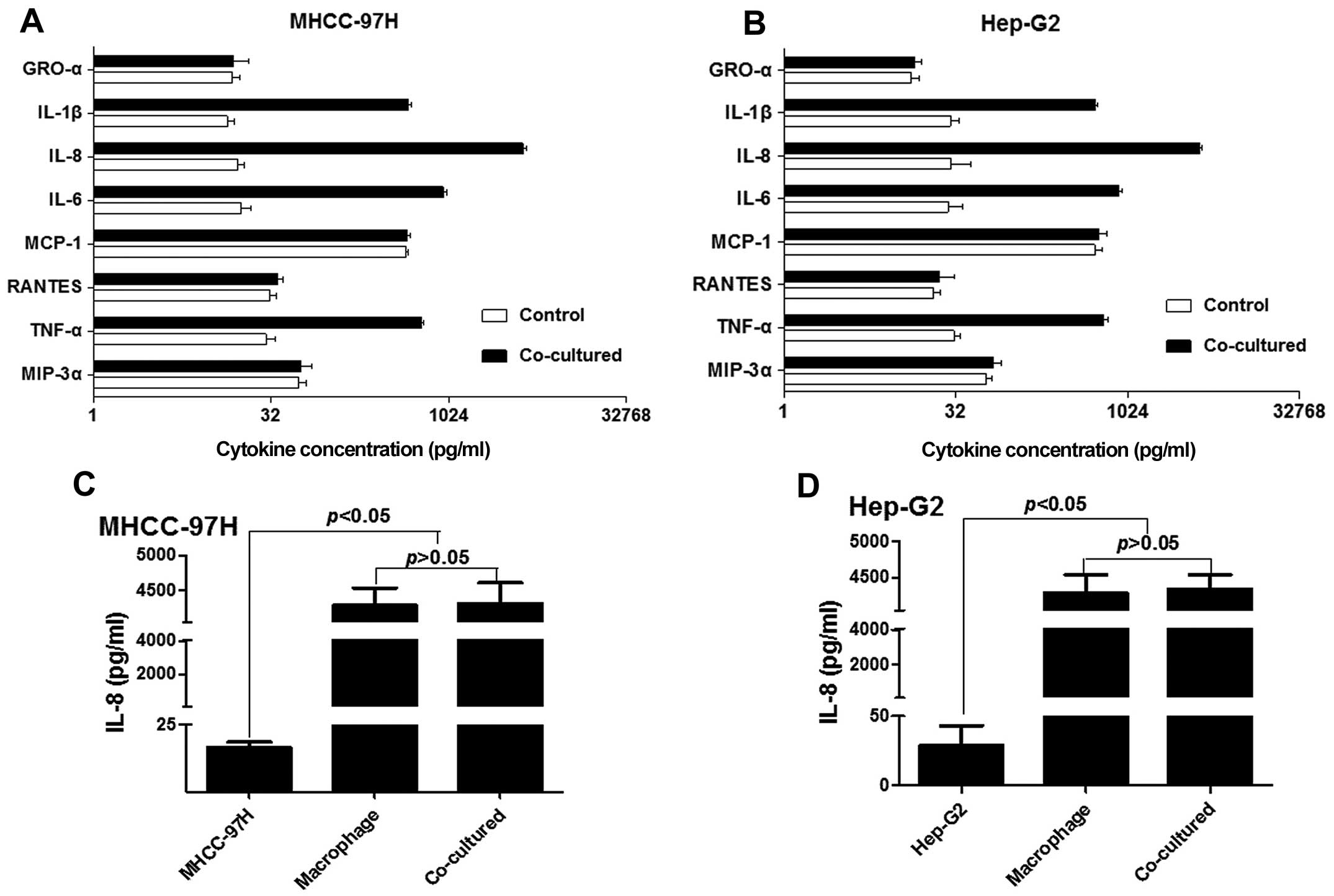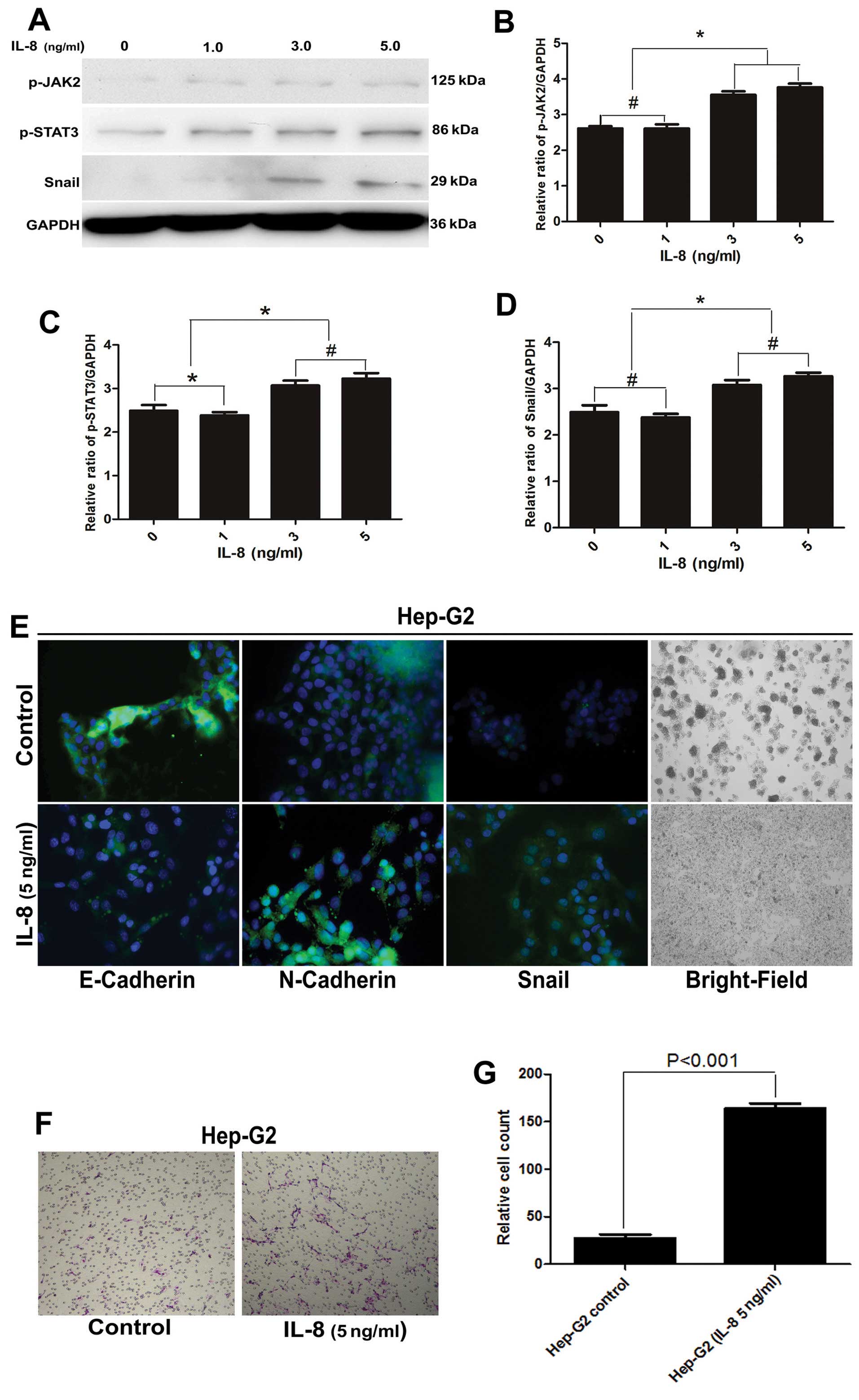|
1
|
El-Serag HB and Rudolph KL: Hepatocellular
carcinoma: epidemiology and molecular carcinogenesis.
Gastroenterology. 132:2557–2576. 2007. View Article : Google Scholar : PubMed/NCBI
|
|
2
|
Clavien PA, Petrowsky H, DeOliveira ML and
Graf R: Strategies for safer liver surgery and partial liver
transplantation. N Engl J Med. 356:1545–1559. 2007. View Article : Google Scholar : PubMed/NCBI
|
|
3
|
Huo TI, Lin HC, Huang YH, et al: The model
for end-stage liver disease-based Japan Integrated Scoring system
may have a better predictive ability for patients with
hepatocellular carcinoma undergoing locoregional therapy. Cancer.
107:141–148. 2006. View Article : Google Scholar : PubMed/NCBI
|
|
4
|
Nakakura EK and Choti MA: Management of
hepatocellular carcinoma. Oncology (Williston Park). 14:1085–1102.
2000.
|
|
5
|
Thiery JP: Epithelial-mesenchymal
transitions in tumour progression. Nat Rev Cancer. 2:442–454. 2002.
View Article : Google Scholar : PubMed/NCBI
|
|
6
|
Yang J and Weinberg RA:
Epithelial-mesenchymal transition: at the crossroads of development
and tumor metastasis. Dev Cell. 14:818–829. 2008. View Article : Google Scholar : PubMed/NCBI
|
|
7
|
Yilmaz M and Christofori G: EMT, the
cytoskeleton, and cancer cell invasion. Cancer Metastasis Rev.
28:15–33. 2009. View Article : Google Scholar : PubMed/NCBI
|
|
8
|
Iwatsuki M, Mimori K, Yokobori T, et al:
Epithelial-mesenchymal transition in cancer development and its
clinical significance. Cancer Sci. 101:293–299. 2010. View Article : Google Scholar
|
|
9
|
Budhu A, Forgues M, Ye QH, et al:
Prediction of venous metastases, recurrence, and prognosis in
hepatocellular carcinoma based on a unique immune response
signature of the liver microenvironment. Cancer Cell. 10:99–111.
2006. View Article : Google Scholar : PubMed/NCBI
|
|
10
|
Sica A, Larghi P, Mancino A, et al:
Macrophage polarization in tumour progression. Semin Cancer Biol.
18:349–355. 2008. View Article : Google Scholar : PubMed/NCBI
|
|
11
|
Zhu XD, Zhang JB, Zhuang PY, et al: High
expression of macrophage colony-stimulating factor in peritumoral
liver tissue is associated with poor survival after curative
resection of hepatocellular carcinoma. J Clin Oncol. 26:2707–2716.
2008. View Article : Google Scholar : PubMed/NCBI
|
|
12
|
Jensen TO, Schmidt H, Moller HJ, et al:
Macrophage markers in serum and tumor have prognostic impact in
American Joint Committee on Cancer stage I/II melanoma. J Clin
Oncol. 27:3330–3337. 2009. View Article : Google Scholar : PubMed/NCBI
|
|
13
|
Chen JJ, Lin YC, Yao PL, et al:
Tumor-associated macrophages: the double-edged sword in cancer
progression. J Clin Oncol. 23:953–964. 2005. View Article : Google Scholar
|
|
14
|
Ding ZB, Shi YH, Zhou J, et al:
Liver-intestine cadherin predicts microvascular invasion and poor
prognosis of hepatitis B virus-positive hepatocellular carcinoma.
Cancer. 115:4753–4765. 2009. View Article : Google Scholar : PubMed/NCBI
|
|
15
|
Fernando RI, Litzinger M, Trono P,
Hamilton DH, Schlom J and Palena C: The T-box transcription factor
Brachyury promotes epithelial-mesenchymal transition in human tumor
cells. J Clin Invest. 120:533–544. 2010. View Article : Google Scholar : PubMed/NCBI
|
|
16
|
Blanco MJ, Moreno-Bueno G, Sarrio D, et
al: Correlation of Snail expression with histological grade and
lymph node status in breast carcinomas. Oncogene. 21:3241–3246.
2002. View Article : Google Scholar : PubMed/NCBI
|
|
17
|
Kwok WK, Ling MT, Lee TW, et al:
Up-regulation of TWIST in prostate cancer and its implication as a
therapeutic target. Cancer Res. 65:5153–5162. 2005. View Article : Google Scholar : PubMed/NCBI
|
|
18
|
Shih JY, Tsai MF, Chang TH, et al:
Transcription repressor slug promotes carcinoma invasion and
predicts outcome of patients with lung adenocarcinoma. Clin Cancer
Res. 11:8070–8078. 2005. View Article : Google Scholar : PubMed/NCBI
|
|
19
|
de Visser KE, Eichten A and Coussens LM:
Paradoxical roles of the immune system during cancer development.
Nat Rev Cancer. 6:24–37. 2006. View
Article : Google Scholar : PubMed/NCBI
|
|
20
|
Korangy F, Hochst B, Manns MP and Greten
TF: Immune responses in hepatocellular carcinoma. Dig Dis.
28:150–154. 2010. View Article : Google Scholar : PubMed/NCBI
|
|
21
|
Bingle L, Brown NJ and Lewis CE: The role
of tumour-associated macrophages in tumour progression:
implications for new anticancer therapies. J Pathol. 196:254–265.
2002. View Article : Google Scholar : PubMed/NCBI
|
|
22
|
Pollard JW: Tumour-educated macrophages
promote tumour progression and metastasis. Nat Rev Cancer. 4:71–78.
2004. View
Article : Google Scholar : PubMed/NCBI
|
|
23
|
Lewis CE and Pollard JW: Distinct role of
macrophages in different tumor microenvironments. Cancer Res.
66:605–612. 2006. View Article : Google Scholar : PubMed/NCBI
|
|
24
|
Siveen KS and Kuttan G: Role of
macrophages in tumour progression. Immunol Lett. 123:97–102. 2009.
View Article : Google Scholar : PubMed/NCBI
|
|
25
|
Stein M, Keshav S, Harris N and Gordon S:
Interleukin 4 potently enhances murine macrophage mannose receptor
activity: a marker of alternative immunologic macrophage
activation. J Exp Med. 176:287–292. 1992. View Article : Google Scholar : PubMed/NCBI
|
|
26
|
Lin EY, Li JF, Gnatovskiy L, et al:
Macrophages regulate the angiogenic switch in a mouse model of
breast cancer. Cancer Res. 66:11238–11246. 2006. View Article : Google Scholar : PubMed/NCBI
|
|
27
|
Zeisberger SM, Odermatt B, Marty C,
Zehnder-Fjallman AH, Ballmer-Hofer K and Schwendener RA:
Clodronate-liposome-mediated depletion of tumour-associated
macrophages: a new and highly effective antiangiogenic therapy
approach. Br J Cancer. 95:272–281. 2006. View Article : Google Scholar : PubMed/NCBI
|
|
28
|
Gocheva V, Wang HW, Gadea BB, et al: IL-4
induces cathepsin protease activity in tumor-associated macrophages
to promote cancer growth and invasion. Genes Dev. 24:241–255. 2010.
View Article : Google Scholar : PubMed/NCBI
|
|
29
|
Chen JJ, Yao PL, Yuan A, et al:
Up-regulation of tumor interleukin- 8 expression by infiltrating
macrophages: its correlation with tumor angiogenesis and patient
survival in non-small cell lung cancer. Clin Cancer Res. 9:729–737.
2003.PubMed/NCBI
|
|
30
|
Strieter RM, Phan SH, Showell HJ, et al:
Monokine-induced neutrophil chemotactic factor gene expression in
human fibroblasts. J Biol Chem. 264:10621–10626. 1989.PubMed/NCBI
|
|
31
|
Strieter RM, Kunkel SL, Showell HJ, et al:
Endothelial cell gene expression of a neutrophil chemotactic factor
by TNF-alpha, LPS, and IL-1 beta. Science. 243:1467–1469. 1989.
View Article : Google Scholar : PubMed/NCBI
|
|
32
|
Kitadai Y, Haruma K, Sumii K, et al:
Expression of interleukin-8 correlates with vascularity in human
gastric carcinomas. Am J Pathol. 152:93–100. 1998.PubMed/NCBI
|
|
33
|
Kooijman R, Himpe E, Potikanond S and
Coppens A: Regulation of interleukin-8 expression in human prostate
cancer cells by insulin-like growth factor-I and inflammatory
cytokines. Growth Horm IGF Res. 17:383–391. 2007. View Article : Google Scholar : PubMed/NCBI
|
|
34
|
Soria G, Ofri-Shahak M, Haas I, et al:
Inflammatory mediators in breast cancer: coordinated expression of
TNFalpha & IL-1beta with CCL2 & CCL5 and effects on
epithelial-to-mesenchymal transition. BMC Cancer. 11:1302011.
View Article : Google Scholar
|
|
35
|
Akiba J, Yano H, Ogasawara S, Higaki K and
Kojiro M: Expression and function of interleukin-8 in human
hepatocellular carcinoma. Int J Oncol. 18:257–264. 2001.PubMed/NCBI
|
|
36
|
Trikha M, Corringham R, Klein B and Rossi
JF: Targeted anti-interleukin-6 monoclonal antibody therapy for
cancer: a review of the rationale and clinical evidence. Clin
Cancer Res. 9:4653–4665. 2003.PubMed/NCBI
|
|
37
|
Tilg H, Wilmer A, Vogel W, et al: Serum
levels of cytokines in chronic liver diseases. Gastroenterology.
103:264–274. 1992.PubMed/NCBI
|
|
38
|
Sullivan NJ, Sasser AK, Axel AE, et al:
Interleukin-6 induces an epithelial-mesenchymal transition
phenotype in human breast cancer cells. Oncogene. 28:2940–2947.
2009. View Article : Google Scholar : PubMed/NCBI
|
|
39
|
Park SH, Kim JH, Lee DH, et al: Luteolin
8-C-beta-fucopyranoside inhibits invasion and suppresses
TPA-induced MMP-9 and IL-8 via ERK/AP-1 and ERK/NF-kappaB signaling
in MCF-7 breast cancer cells. Biochimie. 95:2082–2090. 2013.
View Article : Google Scholar : PubMed/NCBI
|
|
40
|
Lattanzio L, Tonissi F, Torta I, et al:
Role of IL-8 induced angiogenesis in uveal melanoma. Invest New
Drugs. 31:1107–1114. 2013. View Article : Google Scholar : PubMed/NCBI
|
|
41
|
Yuan A, Chen JJ, Yao PL and Yang PC: The
role of interleukin-8 in cancer cells and microenvironment
interaction. Front Biosci. 10:853–865. 2005. View Article : Google Scholar
|
|
42
|
Rajendran P, Ong TH, Chen L, et al:
Suppression of signal transducer and activator of transcription 3
activation by butein inhibits growth of human hepatocellular
carcinoma in vivo. Clin Cancer Res. 17:1425–1439. 2011. View Article : Google Scholar
|
|
43
|
Yang SF, Wang SN, Wu CF, et al: Altered
p-STAT3 (tyr705) expression is associated with histological grading
and intratumour microvessel density in hepatocellular carcinoma. J
Clin Pathol. 60:642–648. 2007. View Article : Google Scholar
|
|
44
|
Ogata H, Kobayashi T, Chinen T, et al:
Deletion of the SOCS3 gene in liver parenchymal cells promotes
hepatitis-induced hepatocarcinogenesis. Gastroenterology.
131:179–193. 2006. View Article : Google Scholar : PubMed/NCBI
|
|
45
|
Colomiere M, Ward AC, Riley C, et al:
Cross talk of signals between EGFR and IL-6R through JAK2/STAT3
mediate epithelial-mesenchymal transition in ovarian carcinomas. Br
J Cancer. 100:134–144. 2009. View Article : Google Scholar :
|
|
46
|
Colomiere M, Findlay J, Ackland L and
Ahmed N: Epidermal growth factor-induced ovarian carcinoma cell
migration is associated with JAK2/STAT3 signals and changes in the
abundance and localization of alpha6beta1 integrin. Int J Biochem
Cell Biol. 41:1034–1045. 2009. View Article : Google Scholar
|
|
47
|
Yadav A, Kumar B, Datta J, Teknos TN and
Kumar P: IL-6 promotes head and neck tumor metastasis by inducing
epithelial-mesenchymal transition via the JAK-STAT3-SNAIL signaling
pathway. Mol Cancer Res. 9:1658–1667. 2011. View Article : Google Scholar : PubMed/NCBI
|
|
48
|
Fernando RI, Castillo MD, Litzinger M,
Hamilton DH and Palena C: IL-8 signaling plays a critical role in
the epithelial-mesenchymal transition of human carcinoma cells.
Cancer Res. 71:5296–5306. 2011. View Article : Google Scholar : PubMed/NCBI
|
|
49
|
Zhou SL, Dai Z, Zhou ZJ, et al:
Overexpression of CXCL5 mediates neutrophil infiltration and
indicates poor prognosis for hepatocellular carcinoma. Hepatology.
56:2242–2254. 2012. View Article : Google Scholar : PubMed/NCBI
|
|
50
|
Xiao YS, Gao Q, Xu XN, et al: Combination
of intratumoral invariant natural killer T cells and
interferon-gamma is associated with prognosis of hepatocellular
carcinoma after curative resection. PLoS One. 8:e703452013.
View Article : Google Scholar : PubMed/NCBI
|
|
51
|
Xia YH, Wang ZM, Chen RX, et al: T-cell
apoptosis induced by intratumoral activated hepatic stellate cells
is associated with lung metastasis in hepatocellular carcinoma.
Oncol Rep. 30:1175–1184. 2013.PubMed/NCBI
|
|
52
|
Yang P, Li QJ, Feng Y, et al:
TGF-beta-miR-34a-CCL22 signaling-induced Treg cell recruitment
promotes venous metastases of HBV-positive hepatocellular
carcinoma. Cancer Cell. 22:291–303. 2012. View Article : Google Scholar : PubMed/NCBI
|

















